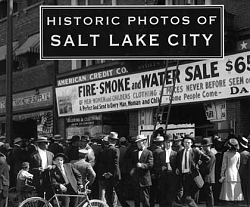Book celebrates city's history and diversity

SALT LAKE CITY — The first photo you see on the title pages of "Historic Photos of Salt Lake City" by Jeff Burbank, is a circa 1950 photo taken from the apex of the City and County Building at 451 South State Street. It has many familiar buildings that are still standing today and a number of older buildings that are gone now. The photo is symbolic of what the book is about. It’s a collection of photos that capture a certain place at a certain time. And even though the book has photos taken between 1887 and 1963, as a reader I still kept scanning the photos – looking for someone I knew. I didn’t find any faces familiar to me, but there are those who will. It couldn’t have been an easy task for Burbank to accumulate this particular collection of photos. He surely had thousands of historic photos from which to choose. The book is divided into eras, and some of the first clues to the changes taking place in the city are the horse-drawn carriages, the early automobiles, and the street lighting mechanisms. Of course the clothes on the people in the photos are sure clues, but the city itself is seen as one of change. And the changes seem like magic. From 1847, when the Mormon Church founded their ZCMI stores – the country’s first department stores – the photos show people of industry. Salt Lake City would go on to be considered a regional center for commerce and tourism. Burbank also places careful emphasis on the immigrants who came to Salt Lake City, some to settle and stay, others who came from the mining regions to visit the city and then return. And he has selected photos that show the progress of the railroad and how that affected the city and its people. People are shown making their way around town on bicycles, with horseless carriages and the earliest of automobiles. The photos document the first electric streetcars and the first businesses. In the late 1880s Salt Lake City was already attracting people from England, Canada, Germany, the Slavic countries, Italians, Greeks, Africans, Chinese and Japanese. All of them would help to build the city, start businesses, and watch as Utah struggled toward statehood. On Jan. 4, 1896, the photos show statehood being celebrated by a diverse people. Fifty years after the first Mormon settlers arrived, Salt Lake City was the largest city in the Intermountain region, Burbank reminds readers. It was linked to the rest of the nation at Promontory Point, and the Denver and Rio Grande Railroad had its depot in the heart of Salt Lake City. By 1880, it was a mining capitol, and although the state took its name from the Ute Indian tribe, Western Shoshone, Bannock, and Navajo Indians also lived within its borders. Photos reveal the celebration of the 50th anniversary of the city’s founding, and in 1902 the building of the City and County Building. Stage coaches delivered goods from ZCMI to people’s homes. And there were tensions between Mormons and Non-Mormons. From 1906 to 1919 the city saw the growth of high-rise buildings; the Boston and Newhouse buildings among them, and the streets changed from cobblestoned to streetcar lines. President Teddy Roosevelt is shown paying a visit to Salt Lake City, where air pollution was becoming a problem and Burbank reported that the Board of Health was paying children 10 cents for every dead rat or every 100 flies they caught. The Salt Palace was destroyed by fire in 1910, Burbank said. The emphasis in the city was on business – growing business, and progress was marked by the electric lamp posts. By 1918, the photos show, traffic lights were being used in Salt Lake City, but the Great Depression stalled public improvements between 1920 and 1939. Still, photos reveal that in the 1920s, Salt Lake City was one of the first municipalities anywhere to replace public trolleys on rails with buses on wheels. According to the 1930 census, Salt Lake City had some 140,000 people of Northwestern European heritage, and during the Great Depression, people still came to visit Temple Square and the ski resorts. Today’s readers will find the Keith O’Brien store a familiar landmark, Sweet’s Candy Store, as well as the ZCMI soda fountain. From the 1940s to the 1960s Salt Lake City enjoyed suburban growth and the city’s economy shifted from mining and railroads to banking, business, and tourism. "Historic Photos of Salt Lake City" is a delightful book. It’s history with more pictures than text, and would make a wonderful gift. It’s a coffee table book that will draw everyone’s attention. I particularly liked looking for buildings that are still standing in 2008, and they’re there. With its emphasis on business, there really isn’t very much on the many churches that have marked history in Salt Lake City. Of course, the addition of those would have made the book too large and unwieldy. I liked watching the fashions change as well as the progression from horse-drawn carriages to cars and trucks. I did find it a bit ironic that our public transportation has moved from tracks to tires and back to tracks. I reminds me of the saying that everything that goes around comes around. Salt Lake City has as interesting a history as any city has. It’s nice to be able to look at it’s history in photos. I’m thinking that Mr. Burbank is working on a book showing Salt Lake City as it moves into the 21st century.
© Copyright 2024 The Diocese of Salt Lake City. All rights reserved.

Stay Connected With Us